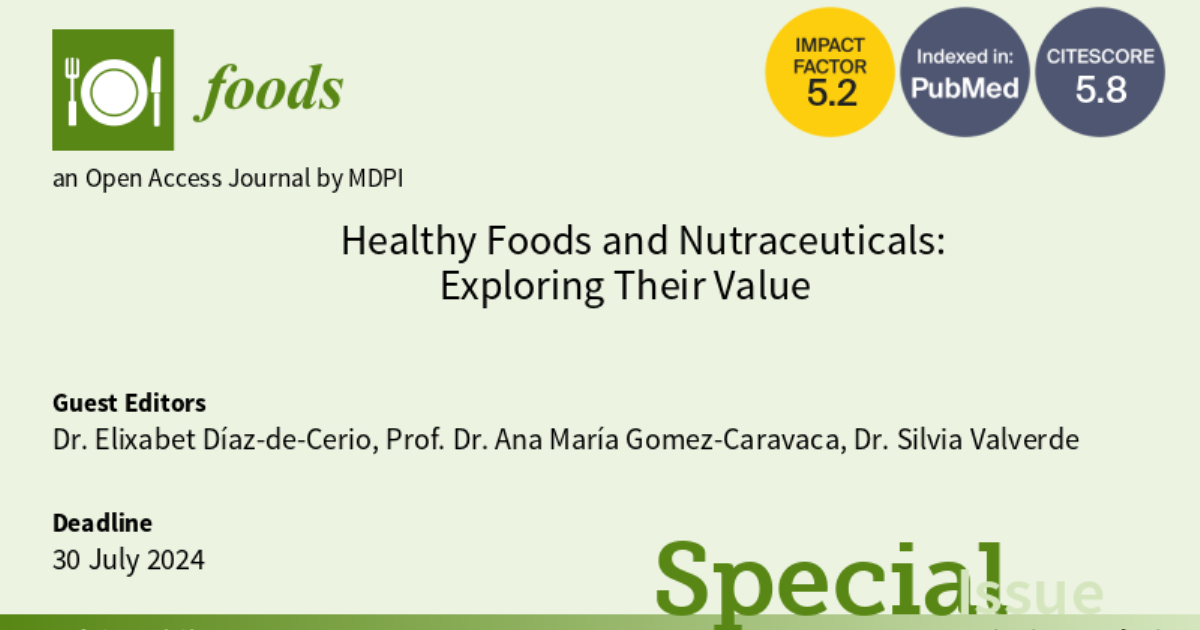Healthy Foods and Nutraceuticals: Exploring Their Value
A special issue of Foods (ISSN 2304-8158). This special issue belongs to the section "Food Nutrition".
Deadline for manuscript submissions: 30 July 2024 | Viewed by 984

Special Issue Editors
Interests: green extraction techniques; circular economy; food by-products; food science; bioactive compounds; phenolic compounds; bioactivity; chromatography; mass spectrometry
Special Issues, Collections and Topics in MDPI journals
Interests: bioactive compounds; metabolomics; analytical techniques; chemical analysis; extraction processes; plant and food analysis; bioavailability; fuctional food; nutraceuticals
Special Issues, Collections and Topics in MDPI journals
Interests: chromatography; sample treatment; mass spectrometry; analytical methods; validation; green chemistry; miniaturization; pesticides; bioactive compounds; pollutants; bee products
Special Issues, Collections and Topics in MDPI journals
Special Issue Information
Dear Colleagues,
Throughout history, food has been a basic need for humans to survive, has been part of the culture of each society, and (along with many plants) has been used in traditional medicine for health care. Nowadays, this relationship between health and diet has become an emergent concern evolving into the consumption of natural products. Thus, healthy foods and nutraceuticals are used for the prevention of many diseases.
This Special Issue, entitled “Healthy Foods and Nutraceuticals: Exploring their Value”, intends to display an overview of the latest trends on this topic, with a specific focus on:
- The bioactive composition of healthy foods and nutraceuticals via the use of advanced analytical techniques (such as LC, GC coupled with MS, and NMR);
- The effect of sample pre-treatment, extraction conditions, and extraction technology;
- The relationship between composition and beneficial health effects (both in vitro and in vivo);
- The valorisation of food waste and further applications.
We look forward to receiving your contributions to this Special Issue, including both original research articles and reviews.
Dr. Elixabet Díaz-de-Cerio
Prof. Dr. Ana María Gomez-Caravaca
Dr. Silvia Valverde
Guest Editors
Manuscript Submission Information
Manuscripts should be submitted online at www.mdpi.com by registering and logging in to this website. Once you are registered, click here to go to the submission form. Manuscripts can be submitted until the deadline. All submissions that pass pre-check are peer-reviewed. Accepted papers will be published continuously in the journal (as soon as accepted) and will be listed together on the special issue website. Research articles, review articles as well as short communications are invited. For planned papers, a title and short abstract (about 100 words) can be sent to the Editorial Office for announcement on this website.
Submitted manuscripts should not have been published previously, nor be under consideration for publication elsewhere (except conference proceedings papers). All manuscripts are thoroughly refereed through a single-blind peer-review process. A guide for authors and other relevant information for submission of manuscripts is available on the Instructions for Authors page. Foods is an international peer-reviewed open access semimonthly journal published by MDPI.
Please visit the Instructions for Authors page before submitting a manuscript. The Article Processing Charge (APC) for publication in this open access journal is 2900 CHF (Swiss Francs). Submitted papers should be well formatted and use good English. Authors may use MDPI's English editing service prior to publication or during author revisions.
Keywords
- bioactive compounds
- nutritional value
- secondary metabolites
- green extraction techniques
- chromatography–mass spectrometry
- bioactivity
- healthy foods
- nutraceuticals
- food wastes
- sample treatment








